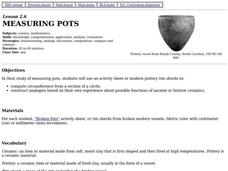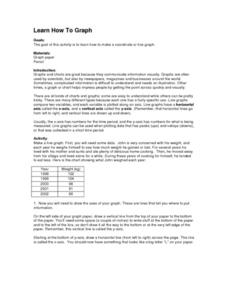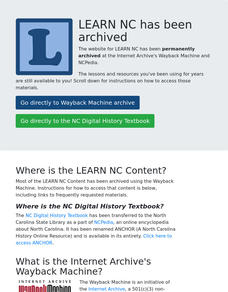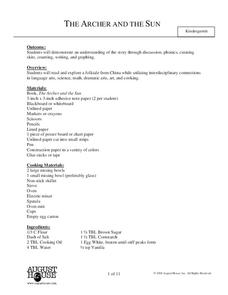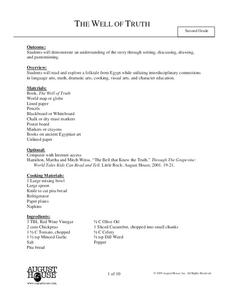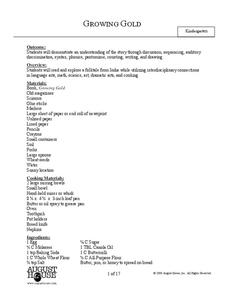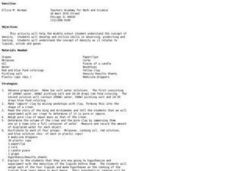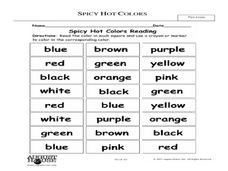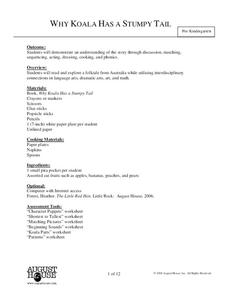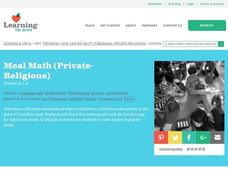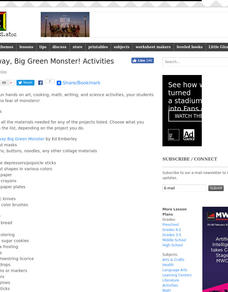Curated OER
Why is it so hot when I sit next to the window?
Students investigate how energy travels through glass. For this energy usage lesson, students conduct an experiment in which they decide if window film affects how much energy travels through the glass. Students use a journal to make...
Curated OER
The Wolf's Chicken Stew 100th Day Celebration
Students celebrate 100 by reading Keiko Kasha's, The Wolf's Chicken Stew, graphing, and making 100 pancakes.
Curated OER
You Are What You Eat (Grades 5-8)
Students gain an enhanced understanding of the relationship between proper nutrition and good health. Through use of video, hands-on activities and interaction, students measure energy in food, and recognize sources of vitamins and...
Curated OER
Measuring Pots
Students use an activity sheet to construct analogies about possible function of ancient or historic ceramics and compute circumference from a section of a circle as they study measuring pots.
Curated OER
Learn How to Graph
Students examine various types of charts and discover how to construct a line graph. Using graph paper, they construct a graph displaying weight loss over a five-year period. They draw copnclusions from the completed graphs.
Curated OER
Understanding Fractions - Cookbook Comparisons
Learners explore equal fractions in relationship to a whole unit. They fold strips of paper into halves, thirds, etc. and compare them to the first strip which represents a "whole unit." Fractional parts are identified and compared.
Captain Planet Foundation
George Washington Carver and the Sweet Potato
Learn about George Washington Carver's important contributions to agriculture by studying the sweet potato. First graders read about the inventor's observations and prepare sweet potato slips for the class garden. Additionally, they...
Curated OER
Icing On The Cake
Eighth graders follow a recipe, focusing on the concepts of ratio and proportion, to mix a batch of icing. They decorate cupcakes in the form of a pumpkin.
Curated OER
Hopping For Candy
Students explore recipes online for different types of candy, and simulate process of making candy to explain how candy makers rely on varied temperatures and basic chemistry to produce perfect sweets.
Curated OER
The Archer and the Sun
Students listen to The Archer and the Sun and participate in interdisciplinary activities related to the book. In this Archer and the Sun lesson plan, students discuss sun and weather and create a graph of the weather they like best-...
Curated OER
The Well of Truth
Second graders explore the Egyptian folktale, The Well of Truth. In this folktale lesson, 2nd graders read the tale and discuss the events from the text. Students write a diary entry from the point of view of a character in the text....
Curated OER
Let's Make a Meal: A Study of Oats
Learners investigate the history and health benefits of oats. For this food history and nutrition lesson, students describe the origin of oats in America, define nutrition related vocabulary, and read and follow recipes for making...
Curated OER
Growing Gold
Young scholars read and explore a folktale from India. In this folktale activity, students read the book Growing Gold and discuss the events from the tale. Young scholars complete a phonics worksheet which incorporates the rhyming words...
Curated OER
Densities
Students explore the concept of density. In this density lesson plan, students determine the density of a crown and a sample of clay. They hypothesize about the densities of 4 liquids they are given including molasses, cooking oil, a red...
Curated OER
Rooster's Night Out
Students explore folktales. For this folktale lesson, students listen to a story from another country and discuss the characters. Students retell the story using puppets and do coloring sheets. Students do a sequencing cut and paste...
Curated OER
Spicy, Hot Colors
Students demonstrate an understanding of colors. In this visual arts lesson, students read the text Hot, Spicy Colors and name their favorite colors. Students complete a bar graph to show the data. Students discuss how each color can...
Curated OER
Spicy Hot Colors
First graders discover the importance of primary colors by reading a book in class. In this art lesson, 1st graders read the book Spicy Hot Colors, and discuss the three primary colors and the numerous combinations they can make....
Curated OER
Why Koala Has A Stumpy Tail
Students practice reading comprehension of an Australian folktale. In this Australian folktale lesson, students read the story, Why Koala Has a Stumpy Tail, before completing retells with character puppets, discussing friendship, and...
Curated OER
What Does it Take to be a Survivor? Part One
Young scholars explore marine animal adaptation. In this introductory ocean life biology instructional activity, students access prior knowledge by participating in a whole class "thought swap." Young scholars form two lines, respond to...
Curated OER
The Kindness Company
Students organize themselves into a simulated company complete with applications, interviews and training. They identify a community need they can fulfill related to cooking or sewing and work to make and deliver the designated product.
Curated OER
Tzedakah: How Can We Help?
Students identify nutritious meals and the prices of a healthy meal. In this nutritious meals lesson, students work in small groups and plan a menu for a nutritious meal. Students figure the total cost of the meal and collect money to...
Curated OER
Apples, Apples, Apples
Students complete activities using apples that help improve their science, math, and reading skills. In this apple lesson, students read the book Apples, Apples Apples and visit an orchard or farmer's market to buy a variety of apples....
Curated OER
Go Away, Big Green Monster! Activities
Students participate in art, math, writing, and science activities to realize they have nothing to fear from monsters. They make masks, shape monsters, toast monsters and monster cookies. They complete monster math problems and make...
Curated OER
Agriculture in Motion
Youngsters learn about simple machines that could be used on a farm. They learn about agricluture, listen to a farmer speak, compare and contrast different farm machines, and then design their own. Note that although the publisher...





